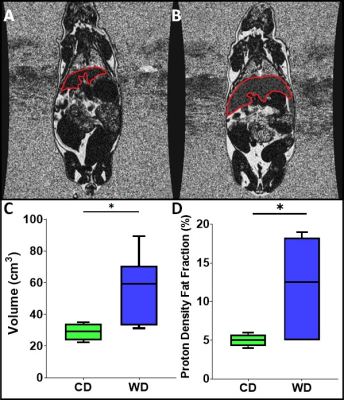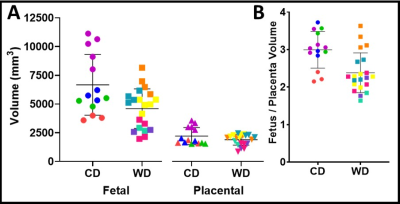Lindsay E Morris1, Flavien Delhaes2, Lanette Friesen Waldner1, Trevor Wade1, Lauren M Smith1, Mary-Ellen ET Empey1, Simran Sethi1, Timothy RH Regnault2,3,4, and Charles A McKenzie1,4
1Medical Biophysics, Western University, London, ON, Canada, 2Physiology and Pharmacology, Western University, London, ON, Canada, 3Obstetrics and Gynaecology, Western University, London, ON, Canada, 4Division of Maternal, Fetal and Newborn Health, Children's Health Research Institute, London, ON, Canada
1Medical Biophysics, Western University, London, ON, Canada, 2Physiology and Pharmacology, Western University, London, ON, Canada, 3Obstetrics and Gynaecology, Western University, London, ON, Canada, 4Division of Maternal, Fetal and Newborn Health, Children's Health Research Institute, London, ON, Canada
The guinea pig maternal liver volume and median fat fraction were significantly higher in Western diet relative to control diet sows. The fetal and placental volumes and placental efficiency were not significantly different between the two diets.

Proton density fat fraction IDEAL image slice of (A) a control diet (CD) guinea pig, and (B) a Western diet (WD) guinea pig, with the liver segmented in red. Note the visibly elevated PDFF in the liver of the WD guinea pig. (C) Maternal liver volumes from T1-weighted images for CD and WD sows (p=0.043), (D) Proton density fat fraction (PDFF) for liver from IDEAL images for CD and WD sows (p=0.040). One star (*) indicates (p<0.05).
